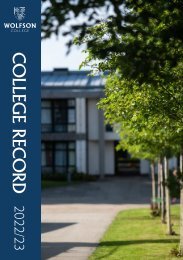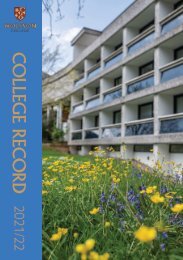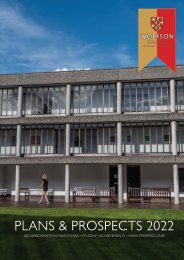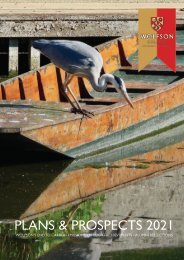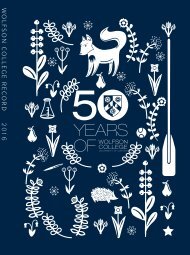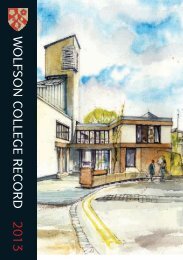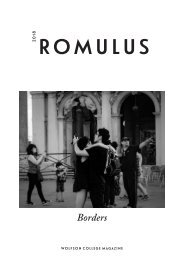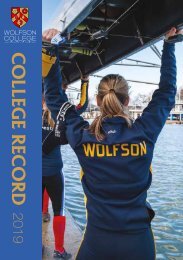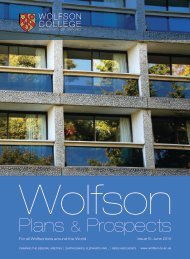Wolfson College Record 2021
You also want an ePaper? Increase the reach of your titles
YUMPU automatically turns print PDFs into web optimized ePapers that Google loves.
The living stone beneath your feet<br />
by Jim Kennedy (EF)<br />
The flooring blocks of the Leonard <strong>Wolfson</strong> Auditorium, café, Academic Wing and<br />
adjacent Stallworthy Quadrangle, are made of 340 million-year old Carboniferous<br />
Limestone from Threecastles Quarry at Kilkenny in Leinster Province, south-east<br />
Ireland. At the time these limestones accumulated, the British Isles formed part<br />
of the continent of Laurasia, made up of North America and Europe west of<br />
the Urals, and lay well to the south of its present position. There was no North<br />
Atlantic Ocean between Europe and North America at that time.<br />
The limestone, commonly known as Irish Blue Limestone, is made up of grains of<br />
calcite – a form of calcium carbonate – derived from the skeletons of a range of<br />
marine organisms, and accumulated on a shallow sea floor in turbid waters. The<br />
colour of the limestone reflects the presence of land-derived clays. The blocks in<br />
the Stallworthy Grove and flooring the café come from a level in the sequence<br />
where stable sea floors supported a rich fauna, dominated by corals, brachiopods<br />
and crinoids, their calcite skeletons white against the blue-black limestone matrix.<br />
In contrast, the flooring blocks by the Lodge desk and outside the entrance come<br />
from a different part of the sequence, with few obvious fossils. They have a subtle<br />
mottled appearance, the result of the carbonate sediment that was ultimately<br />
transformed into limestone having been churned over by successive generations of<br />
soft-bodied organisms, whose only record is their burrows.<br />
The living stone<br />
To return to the fossils. The corals belong to two extinct groups, known as<br />
tabulate and rugose corals. Unlike modern reef-building corals, they probably<br />
lacked the symbiotic organisms (zooxanthellae) that limit present-day reef<br />
development to the photic zone (the zone of light penetration). Several types<br />
are present. Massive colonies, built of close-packed polygonal corallites belong<br />
to the genus Palaeosmilia. Each corallite was secreted by a single polyp, a sea<br />
anenome-like individual. A second rugose coral, Lithostrotion, is made up of<br />
cylindrical corallites, and appears as areas of circular sections around a centimetre<br />
in diameter, with radiating septa within. Areas of much smaller circular sections<br />
belong to a second species of Lithostrotion. Colonies of the tabulate coral<br />
Michelinia have polygonal corallites, but lack septa.<br />
wolfson.ox.ac.uk<br />
101



